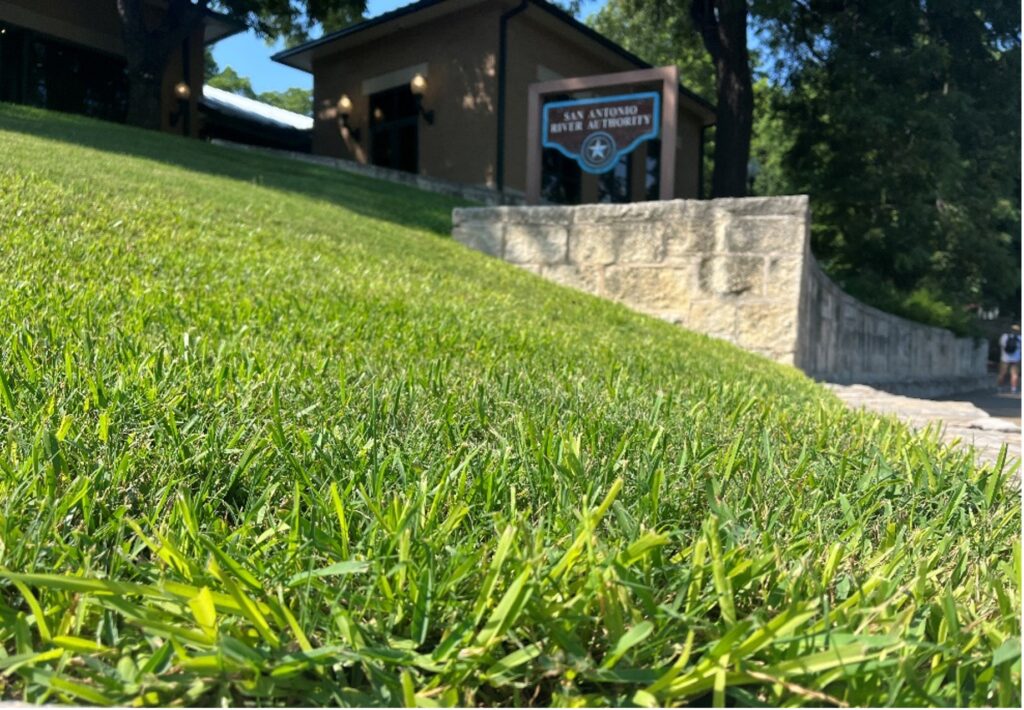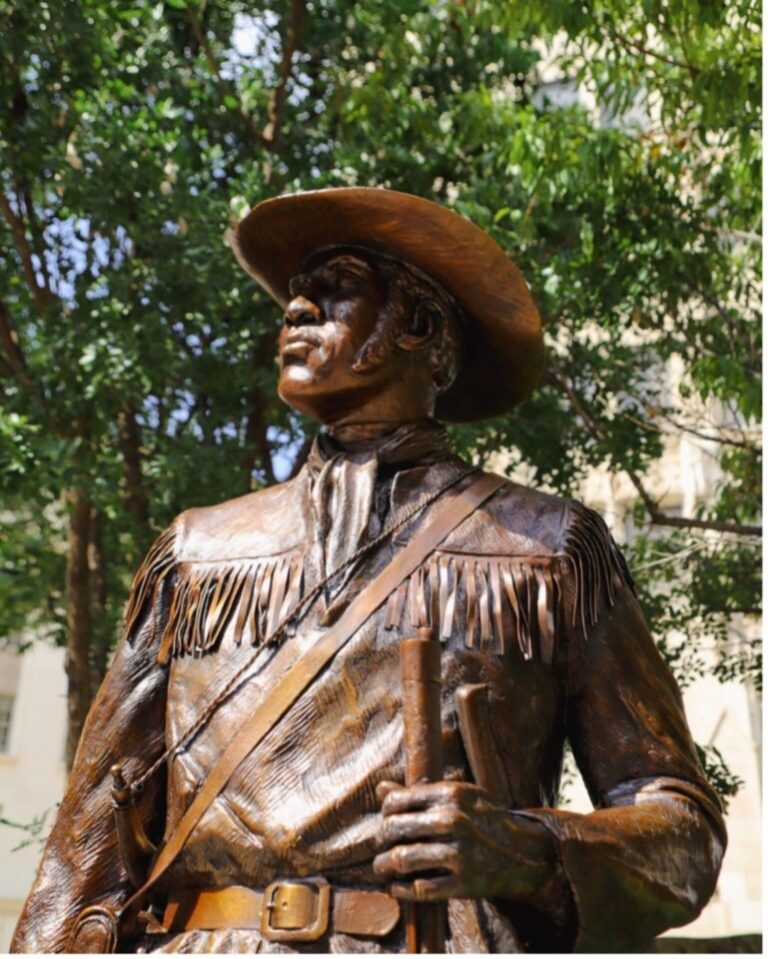Última actualización el 30 de enero de 2024
El calor del verano se ha instalado aquí en el Cuenca del río San Antonio! Este calor significa que las lluvias de verano tendrán poco impacto en la mayoría de los céspedes y plantas. Entonces, ¿cómo puedes regar tu jardín y mantenerlo en buen estado y al mismo tiempo ser respetuoso con nuestras cuencas y acuíferos?
San Antonio tiene una precipitación media anual de alrededor de 32,4”. Eso es bastante precipitación: el lluvioso Portland, Oregón, recibe solo 4 pulgadas más a 36”. Sin embargo, San Antonio recibe las precipitaciones principalmente en grandes tormentas de primavera y principios de otoño en lugar de distribuirse a lo largo del año. Esto significa que durante los meses cálidos y secos, puede haber mucha presión sobre los recursos hídricos. De hecho, una investigación de la Junta de Desarrollo del Agua de Texas encontró que los habitantes de San Antonio utilizaron aproximadamente 25% de suministros municipales de agua solo en sus jardines! Para una ciudad con más de un millón de habitantes, ¡eso es mucha agua! Nuestro uso del agua afecta directamente la salud de los ecosistemas y la vida silvestre que dependen de nuestras vías fluviales locales. Menos agua en nuestros acuíferos significa menos agua fluyendo en nuestros arroyos y ríos.
Lea a continuación algunos aspectos clave a considerar al regar sus jardines, ¡especialmente en verano!
Cuidado del césped en verano
San Antonio Water System (SAWS), la empresa de agua potable y alcantarillado más grande del condado de Bexar, establece restricciones de agua principalmente para proteger el Acuífero Edwards y sus especies endémicas, como la Salamandra ciega de Texas (Eurycea ratbuni). Si SAWS no es su proveedor de agua en el condado de Bexar, o si vive en los condados de Wilson, Karnes y Goliad, consulte con su municipio local o utilice este búsqueda de servicios de agua para encontrar cualquier normativa que pueda aplicarse a usted. Antes de regar es fundamental Consulta estas normas para evitar multas. ¡Y para ser más efectivo con su riego!
Estas raíces no son profundas
¿Sabía que la mayoría de los céspedes suelen tener raíces muy poco profundas? Los céspedes más comunes en los céspedes típicos son pasto bermuda costero (cynodon dactilon) o Hierba de San Agustín (Stenotaphrum secundatum), que tienen raíces que normalmente sólo alcanzan de cinco a seis pulgadas de profundidad en el suelo. Al regar el césped, las plantas no absorben agua más allá de la zona de sus raíces y, en muchos casos, ni siquiera toda la profundidad de sus raíces. Debido a que la zona de la raíz es un área tan pequeña y poco profunda, es propensa a secarse rápidamente y a alcanzar su máxima capacidad de saturación.
Las estructuras de las raíces de especies de plantas nativas versus no nativas. ¡Tenga en cuenta que apenas se pueden ver las raíces del césped no nativo (el cuarto desde la izquierda)! Foto cortesía del Consejo Regional Mid-America
¡Aún puedes marcar la diferencia incluso si tienes césped! El césped y muchas plantas de nuestra zona se benefician de un riego poco frecuente, lo que obliga a sus raíces a ser más profundas y las hace más resistentes. El césped sólo necesita una pulgada de agua por semana. Si usa una manguera de jardín o un sistema de rociadores, coloque un pluviómetro enterrado o un recipiente pequeño en su área de riego y calcule el tiempo que lleva llenar los recipientes en aproximadamente una pulgada. Regar más que esto proporciona más agua de la que sus plantas pueden utilizar.
Consejos para regar eficazmente el césped
También puedes ahorrar agua según la forma en que la aplicas. Si usa un aspersor, asegúrese de que las gotas sean grandes y que no haya niebla ni rocío fino. Las gotas más grandes tienden a caer al suelo y al suelo, mientras que las gotas más finas, como la niebla, se evaporan antes de llegar al suelo. También podría ayudar ajustar el canalón de lluvia hacia su jardín en lugar de hacia la calle o instalar un barril de lluvia alrededor de su casa. Desde solo una sección de techo de 20×20 pies, Podrías recolectar 80 galones con media pulgada de lluvia.! Al implementar estas pequeñas acciones, usted hará su parte para ejercer menos presión sobre los recursos hídricos durante las épocas secas.
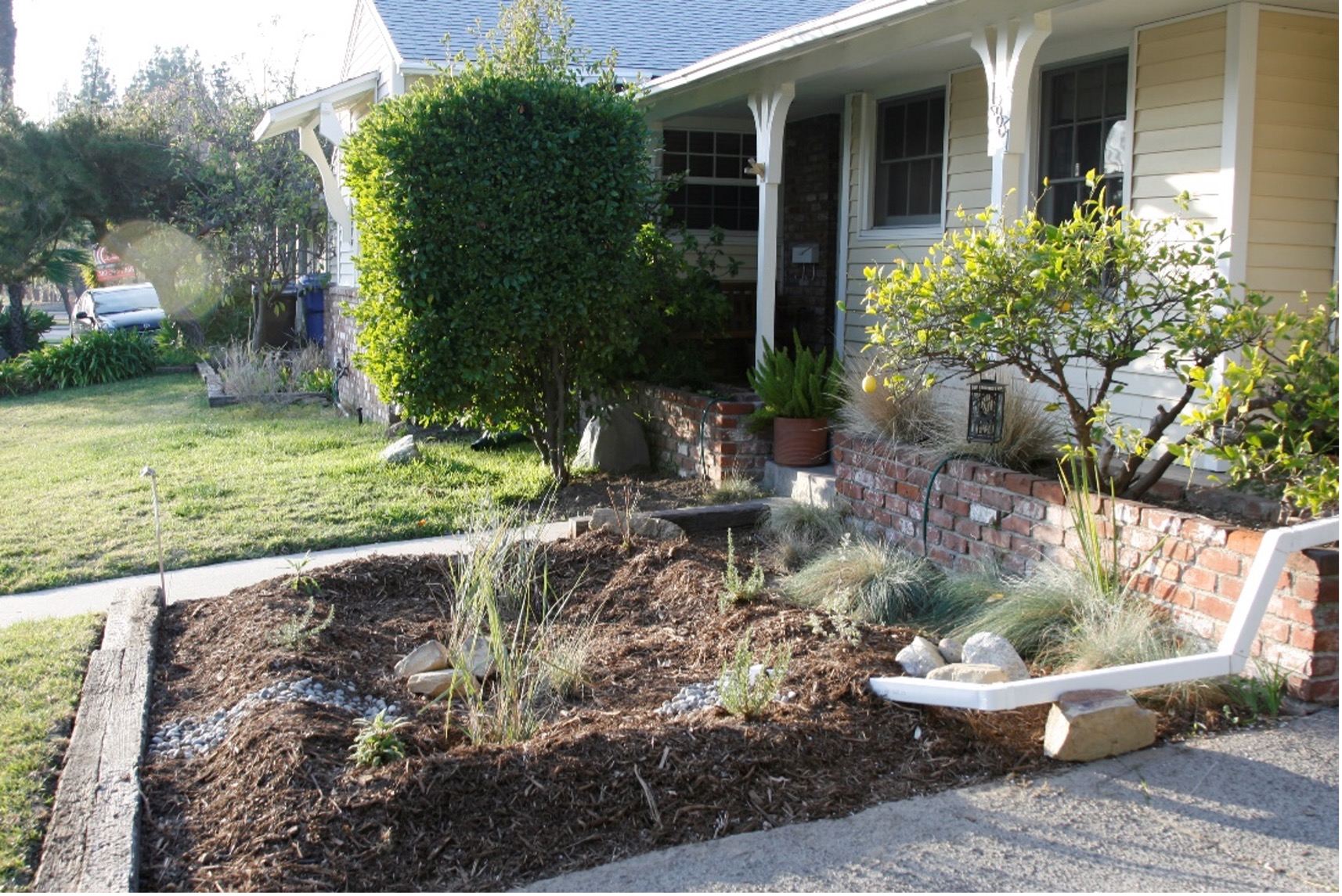
Extender o girar la bajante de su canal hacia un jardín en lugar de hacia el camino de entrada ayuda a conservar agua.
Conservación del agua
La altura de corte también puede afectar la cantidad de agua que necesita su césped. Cortar el césped demasiado corto hará que la zona poco profunda de las raíces (área de absorción de agua) se seque más rápido en el verano. Mantener el césped a una altura de 3 a 4 pulgadas ayudará a dar sombra a la capa superior del suelo, protegiendo el suelo húmedo de temperaturas extremas y haciendo que su césped esté más feliz hasta el próximo día de riego. Debido a que las temperaturas se vuelven tan extremas con un alto potencial de evapotranspiración durante la mitad del día, es mejor ceñirse a las horas de riego del SAWS (7-11), incluso cuando las restricciones no estén vigentes. ¡Esto es especialmente importante durante los meses de verano, cuando las temperaturas pueden alcanzar los 90° al mediodía!
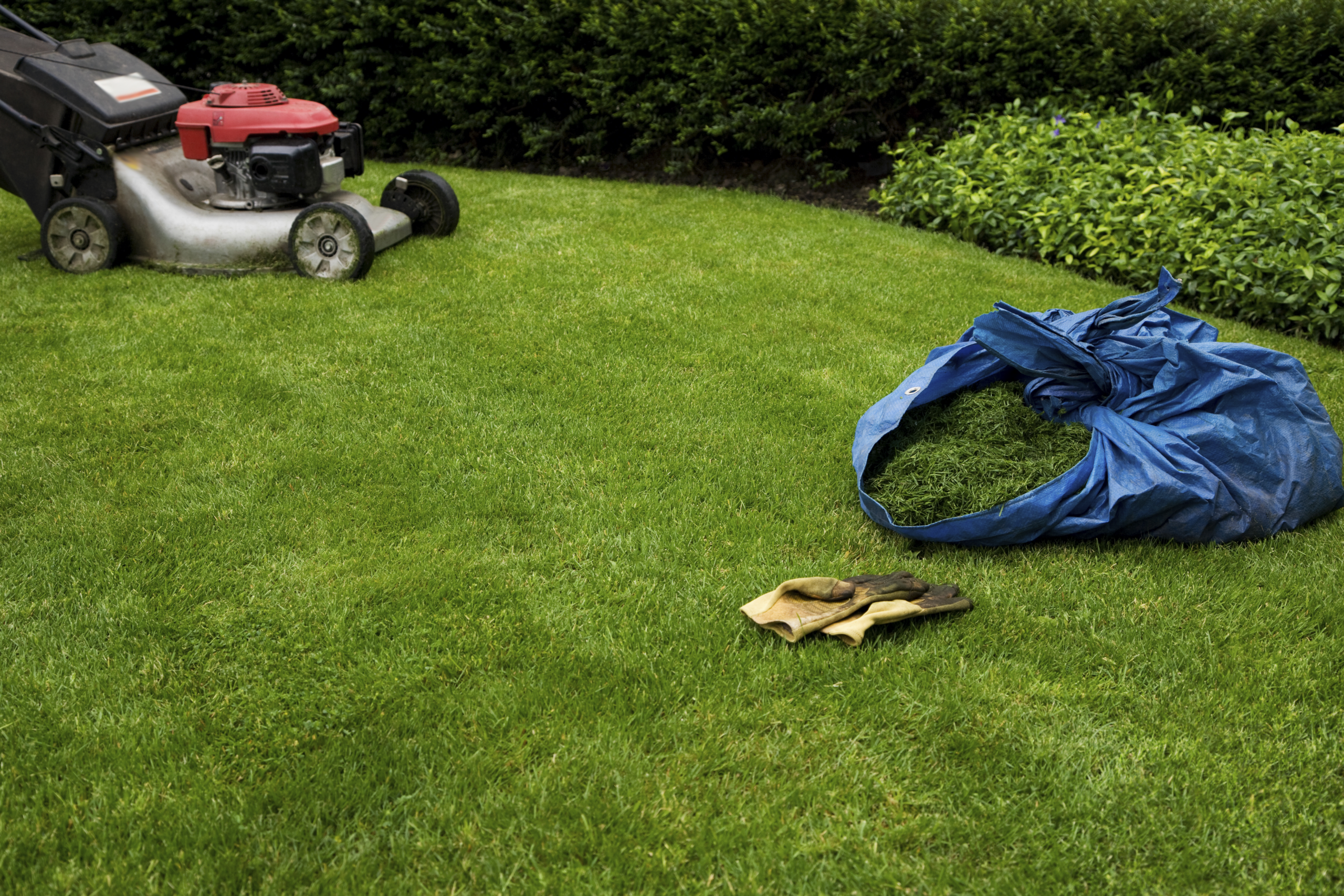
Recuerde: ¡el pasto un poco más alto es pasto feliz!
¿Quieres ser el máximo conservacionista del agua? – reemplace su césped con plantas autóctonas que no requieren riego adicional, ¡ni siquiera en verano! Aunque el verano no es la época ideal para plantar, es un buen momento para planificar un nuevo paisaje o un pequeño jardín de plantas nativas. Las plantas nativas están adaptadas a nuestro clima, suelos y patrones climáticos, lo que significa que son inherentemente tolerantes a la sequía y pueden soportar temperaturas extremas. ¡También brindan una amplia gama de emocionantes interacciones con follaje, flores y vida silvestre para que disfrutemos durante todo el año! Verificar estos recursos sobre plantas nativas de su área.
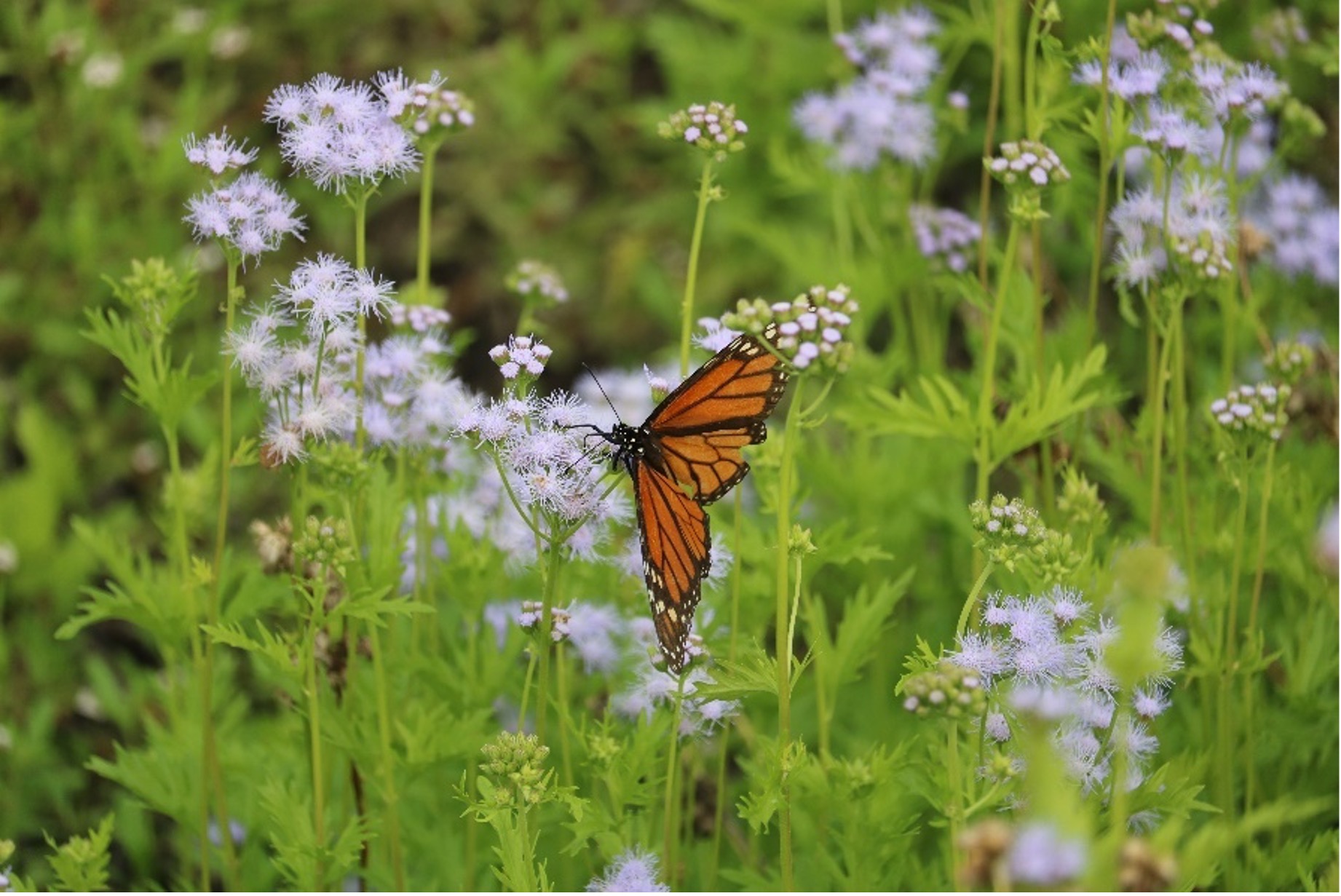
La flor de niebla de Gregg (Conoclinium greggii) es una planta nativa popular y ampliamente disponible que atrae a una variedad de polinizadores con sus difusas flores de color azul violeta.
En nuestra cuenca semiárida de San Antonio, los recursos hídricos siempre tienen una gran demanda. Por lo tanto, siempre es importante tener en cuenta las cuencas hidrográficas de cualquier paisaje, grande o pequeño: ¡todo está conectado con el río San Antonio!

